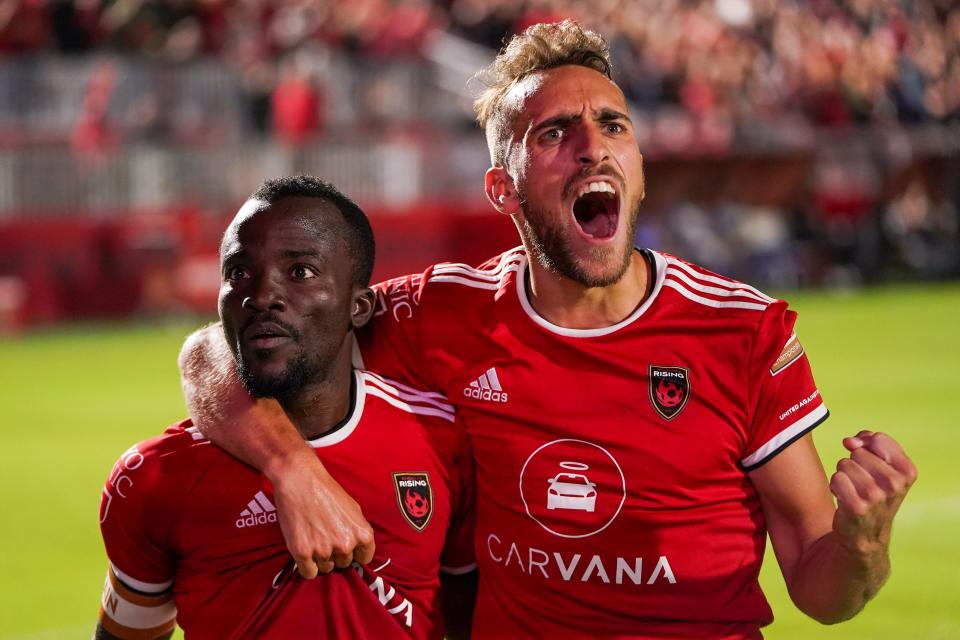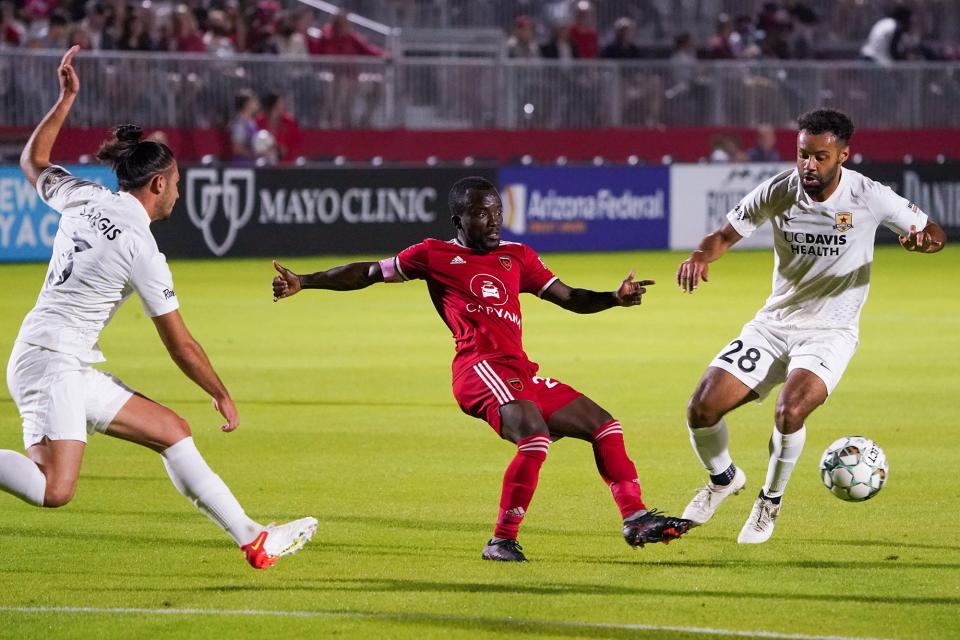Here's why it's difficult for players from Phoenix Rising, other USL teams to make the leap to MLS
- Oops!Something went wrong.Please try again later.
For the past five years, Phoenix Rising has — with this season as a notable exception — been among the USL Championship’s best clubs.
When players sign with Phoenix, they echo this refrain. The logic, they say, is that by playing for one of the league’s premier teams, they’ll be on the radar of MLS clubs.
Time and again, though, that logic has failed. Only a handful of players — Adam Jahn, Amadou Dia and James Musa — have moved directly from Rising to MLS. Even standouts like Solomon Asante and Junior Flemmings have only found a home at the USL level when they’ve departed.

It’s a trend that’s in line with the way MLS operates as a whole. Among the 20 starting outfield players in last year’s MLS Cup, only NYCFC’s James Sands had ever played for an independent USL club.
In contrast, top European leagues are loaded with players who have spent time in those countries’ respective second divisions. Robert Lewandowski, Erling Haaland and N’Golo Kante are among the sport’s superstars who began their professional careers in the second division.
All of this was in the mind of Dan Egner when he became Real Salt Lake’s technical director in December 2019.
Having previously served as the general manager of Real Monarchs — RSL’s USL affiliate — Egner brought with him a unique perspective. He wanted to bring in more USL players, taking advantage of what he perceived as a market inefficiency.
“As a soccer nation, our second division shouldn't just be cast aside or overlooked by MLS sides because there's a lot of quality there,” Egner said.
During his time at Real Salt Lake, Egner — who now works as an agent — experienced repeated disagreements when attempting to bring in USL players.
“It would be difficult for the first-team coaching staff to even bring up players from the USL team into training,” Egner said. “They'd be reluctant to do that.”
On one occasion, Egner added, “We got pushback from the league office when we wanted to bring in a USL player to our MLS team. He was on an independent USL team. And we got pushback from the league on that and we were gonna pay a transfer fee and it was minimal.”
Ego-driven or legitimate reasons?
Andy Williams, a former MLS scout who now manages NPSL club FC Arizona, said that for him to scout a USL player, “it would have to be recommended by a coach.” Outside of the postseason, Williams added, it was rare for him to go to USL games.
All of this may paint the picture of a league stubbornly set in its ways, one that won’t give USL players opportunities solely out of pride.
“MLS can be very ego-driven and these are theoretically guys that you could've had at any point,” Egner said.
But there are plenty of legitimate reasons that USL players rarely make the leap to MLS.
For one, many of the best players in USL are foreign. Among MLS’s 28 teams, there are only 224 international roster spots available — eight per team. While those roster spots are tradeable, their limited nature means that they’re often reserved for players who are expected to make an immediate impact.
“Take Kyle Vassell at San Diego,” Egner said. “Could he play in MLS? Yes. Is it unlikely for him because he's an international player? Yes.”
The same logic holds true for players like Óttar Magnús Karlsson and Michee Ngalina, who have been among USL’s top scorers this season.
“Outside of those guys, you're looking at a lot of guys who could be on rosters, but they're probably not gonna contribute much or play,” Egner said.
That raises a separate set of issues. The MLS veteran minimum salary this season is $84,000 whereas USL stars can make upwards of $100,000. While MLS is inherently appealing to players as the country's top-level soccer league, it becomes less so with a trade-off of less money and less playing time.
The nationality and salary drawbacks — in addition to his slight frame — are the reason Asante never made the leap to MLS when he was named USL MVP in 2019 and 2020, according to Egner.

With those constraints complicating the leap to MLS for older USL players, most of those who sign with MLS clubs are younger. The problem with younger players, though, is that many USL academies still lag behind their MLS counterparts.
While every MLS club has academy teams in the 132-club MLS Next system, only five USL clubs do. And although most of the other independent USL clubs do have fledging academy systems, many of those remain pay-to-play, which hinders their ability to attract players.
“I can tell you from being at all of these academies in some of the last few years, the MLS Next academy system, even the independent clubs, it's a much higher level,” Egner said.
Even USL clubs who are in MLS Next — like Rising — have disadvantages compared to their MLS counterparts. They can’t offer a direct pathway to MLS, they have limited financial means and they haven’t been up and running as long as MLS academies.
Related: For Rising FC, academy players training with first team is a symbiotic relationship
Three years ago, for example, Rising had Caden Clark and Diego Luna in training. But because their academy wasn’t at the level that it is today, manager Rick Schantz says now that, “We weren't quite ready at the time to make those types of signings.”
Instead, both stayed with the Barcelona Residency Academy in Casa Grande.
“But I think now, you're starting to see more and more USL clubs are expanding their ability to manage younger players,” Schantz said. “Their academies are improving, the budgets are changing a little bit so you can have some younger guys on the roster and still have some veteran guys to help them. So I think what you're starting to see now is a good route to go through the USL, maybe it keeps you more of a free agent and open to the rest of the world.”
Orange County center-back Kobi Henry, 18, recently took that route, signing with French Ligue I club Stade de Reims. He’s part of a growing class of USL success stories, like Jonathan Gomez (who moved from Louisville City to Spanish side Real Sociedad) and Luna, who signed with Real Salt Lake from El Paso Locomotive earlier this month for a reported $250,000 — a record for an MLS-to-USL transfer.
Even that figure, though, strikes Egner as low for a starter on the US U-20 national team who has proven himself in a professional setting.
“If he was Uruguayan or Colombian,” Egner said, “that number would also start with a '2', but it would have an extra '0' at the end of it and MLS teams would happily pay for it.”
Why?
“A little bit of it is that they think the re-sell value is gonna be higher on the Uruguayan or they think that you get more exposure, being a foreign player in this league, being a high-profile transfer,” Egner said. “But at the end of the day, it shouldn't, it's exactly the same.”
Egner also believes that MLS clubs view USL as being worse than it is. His closest comparisons for USL’s quality around the world are the second divisions in Sweden and Norway and the middle tier of the Costa Rican first division. And while USL clubs might overrate the league’s quality, MLS clubs underrate it.
That disconnect serves to stagnate the careers of other promising prospects who are, like Luna, young, American and cheap — the rare combination that should, in theory, make a USL player appealing to MLS clubs.
“This is great progress,” Egner said of Luna’s transfer. “But there's still a lot of work to go.”
Read more: How a growing pipeline brought Rising FC's Claudio Repetto from Italy to the U.S.
Up next
Phoenix Rising FC at Las Vegas Lights, 7:30 p.m., Bally Sports Arizona, ESPN+
When Phoenix Rising lost, 2-1, to the Las Vegas Lights on March 19, it was the first sign that this season might not go as well as the previous four. Three months later, Rising returns to Las Vegas for Friday night’s game against the Lights. Phoenix enters below .500 and in 11th place out of 13 Western Conference teams at 7-0-8. After that loss in Las Vegas, Rising seemingly rebounded, winning seven of their next nine games. However, they’ve now lost six of seven since May 11, raising questions over the security of manager Rick Schantz’s job. ... The Lights have been in the middle of the pack this year. They’re 6-4-6 and sit in eighth place in the Western Conference. Danny Trejo and Cal Jennings are tied for the most goals on Las Vegas at five apiece ... After scoring just three times in their previous six games, goals were not the problem for Phoenix in last weekend’s 4-3 loss to Loudoun United. However, they have now conceded 31 goals, the fourth most in the USL.
Theo Mackie covers Arizona high school sports and Phoenix Rising FC. He can be reached by email at theo.mackie@gannett.com and on Twitter @theo_mackie.
This article originally appeared on Arizona Republic: Why is it so rare for USL players to make the leap to MLS?

